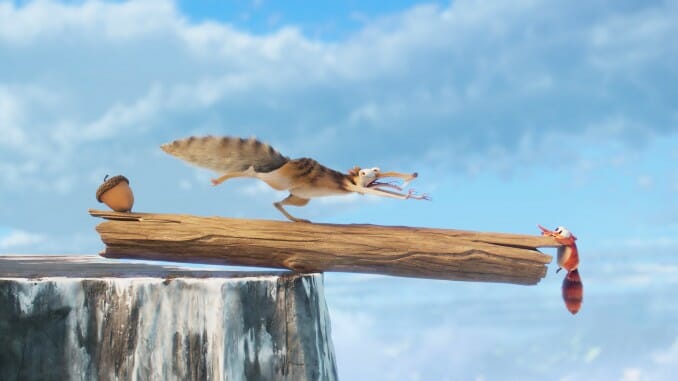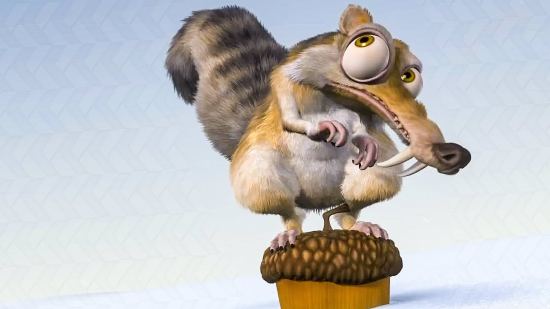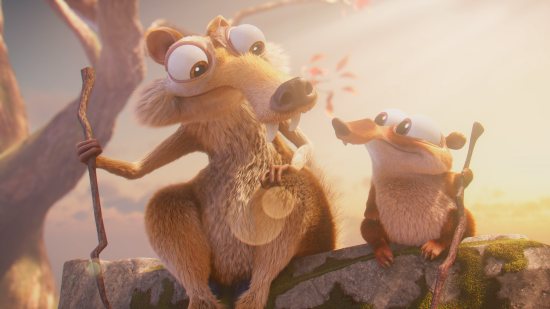An Oral History of Scrat Tales: The Death and Legacy of Blue Sky Studios

When you think of the founding studios of modern CG animation, Pixar and DreamWorks Animation immediately come to mind. But for 34 years, Blue Sky Studios was also part of that vanguard of technology and creativity, operating as both a pioneer and an outlier in the computer animation world. But its entire history came to an unexpected, grinding halt on April 10, 2021, when the studio’s new owner, The Walt Disney Company, closed Blue Sky forever. Ironically, the last endeavor produced with its creatives under its own roof, Ice Age: Scrat Tales, premieres April 13, almost exactly a year later, on Disney+.
The six-short series is a bittersweet swan song for Blue Sky Studios, as it features Scrat, the tunnel-visioned, saber-toothed squirrel who opened their very first film, Ice Age, and now brings the creative entity to its close. Since the close of Blue Sky Studios happened so quickly, Paste reached out to the creative team behind Ice Age: Scrat Tales—including Chris Wedge, Anthony Nisi and Michael Knapp—to get the full story of how this Scrat-focused entry, which was supposed to signify a new chapter for the company, became its coda.
A Brief History of Blue Sky Studios
Co-founded in 1987 by a collective of tech orphans after the shut down of MAGI, an early computer visual effects company that worked on Tron, Blue Sky Studios was conceived to be a turnkey operation that would produce creative visuals for their clients in-house, using their proprietary software CGI Studio.
After making a name for itself creating computer animation for clients like M&Ms and MTV, Blue Sky saw 20th Century Fox’s VFX company, VIFX, acquire a majority interest in 1997. They retained the creative team and had them build complex VFX shots for a host of Fox movies. However, the trajectory of the company changed when Bunny, by co-founder Chris Wedge, won the 1998 Academy Award for Best Animated Short Film.
The company reoriented towards making CG features: From 2000 to 2019, Blue Sky Studios released 13 theatrical CG animated films (taking in more than $5B at the box office and earning a pair of Oscar noms for Best Animated Feature) and a myriad of shorts and television specials, all produced inside the unassuming walls of a bland corporate park building in Greenwich, Connecticut. Ice Age, which had five theatrical installments, originated Scrat—the character who eventually became their studio mascot and corporate logo.
Chris Wedge, Blue Sky Studios co-founder and director: The very first day of Scrat was me, [character designer] Peter de Sève and [storyboard artist] Bill Frake. It was a meeting that took on a life of its own and took over the afternoon, as I remember. It came from my wanting to start Ice Age differently. In the script, there was a migration happening. It was fall and Manny’s going north, against the grain, and we weren’t gonna see any snow until act two. I wanted to start the film comedically, and I thought maybe to get some ice on the screen at the beginning we should make the environment itself into a character.
What about the ice age would be a character that we could use? We thought a glacier could be chasing somebody. Well, who should it be chasing? It should obviously be the smallest character we can come up with. Peter went through a stack of drawings that he’d been working with characters we hadn’t used yet, and he pulled out this sketch of a squirrel that he had made at the Museum of Natural History. Let’s put some saber teeth on that guy, and the story is obviously that he’s trying to store his nuts for the winter and the glacier won’t let him do it.
Frake took the afternoon to storyboard the opening sequence, which had Scrat ultimately getting squashed by a huge mammoth foot. The darkly comedic sequence implied “that’s life in the Ice Age,” which primed the audience for what was to come. The Fox marketing team decided to use the sequence as the film’s first teaser trailer, which Wedge hated.
Wedge: I fought so hard against it! But obviously it was their decision to make and it wasn’t mine. And so they used it and it turned out very well for us. But it also cemented Scrat’s extended role, and extended Scrat’s life.
The Acquisition
Blue Sky Studios’ fate started to change on March 20, 2019, the day Disney’s acquisition of 21st Century Fox was completed. In the immediate aftermath of the transition, the studio operated per usual. By August, there was a new co-president of Blue Sky—Andrew Millstein, formerly of Walt Disney Animation—but ongoing development and current projects such as Spies in Disguise and the planned adaptation of the comic Nimona continued. Internal morale was wary but positive.
Wedge: In my own optimistic naivete, I thought Disney was buying everything else in Hollywood, so this was just gonna happen. There’s no shortage of need for content, and that’s what we do. My naïve assumption was that they would just own 20th Century Fox and profit off of that brand. And for animation, it can be animation that isn’t the Disney brand. It can be Blue Sky and we can experiment more creatively. We can push into boundaries where there are little landmines here and there, but we’ll find our way through them.
Mike Knapp, Scrat Tales production designer: I think some people were more concerned than others. I tend to be an optimist. There was a hope that being under an umbrella of a company that understood animation as a medium would be great for us. For a little while, it felt like it was easier to leave us alone and to let us do our thing. I was in the middle of Spies in Disguise and we were all able to embrace what felt like creative autonomy, to some degree. We were making the best version of the movie that we could and got a lot less resistance on certain creative fronts and that was a nice taste.
Anthony Nisi, Scrat Tales producer: I was more of that mind that Disney is an animation company. It was founded and built upon animation. Obviously, Blue Sky was not part of the plan when they purchased Fox, but I was always hopeful that they would see the value. Unfortunately, that was not the case.
Scrat Tales and the Beginning of the End
With the start of the new year, Blue Sky Studios leadership was looking for creative opportunities to show their value to Disney, especially Disney+ which needed ongoing content. Blue Sky was also developing in-house programs to foster internal talent. The pitch for Ice Age: Scrat Tales served both needs and originated with longtime Blue Sky animator, Michael Berardini.
Wedge: The idea behind Scrat Tales was that we were going to put an open call out for ideas. We were going to organize a development effort, but it was also an open call for ideas. When we got the notion for the limited series together, we cast directing talent who we hadn’t used before. We just looked inside the company for the best people. Most of them were in animation or story, but it was an opportunity for people that didn’t expect to have it.
Knapp: Michael Berardini is the director of the first episode. But originally, he and his wife, Mindy, had recently had their son, Charlie. They were both over the moon, but Mike was such a giddy father. And from that he was like, “What if Scrat had to take care of a baby?” And if Scrat’s adopting this kid, and he’s got the nut, then he’s got these different things tugging in his mind. And then he discovers that the baby wants the acorn too, so now what do you do? It opened up a whole other facet of his conflicted self. And it’s fun to watch him struggle and suffer and be tormented by rational thought.
It was [production managers] Rob Baird and Bruce Anderson who reached out to me and said, “Hey, we’ve got this thing that we’re trying to pull together as a pitch.” We pulled in Jason Sadler to do some character designs and then we pitched it. The last short I worked on was “No Time for Nuts” in 2005/2006, so this was really fun to get back to Scrat, which is a super simple focus. With Scrat, it’s fun to get back to that childlike purity of zaniness and anything goes. Disney was super receptive and they were like “full steam ahead.”
-

-

-

-

-

-

-

-

-

-

-

-

-

-

-

-

-

-

-

-

-

-

-

-

-

-

-

-

-

-

-

-

-

-

-

-

-

-

-

-









































